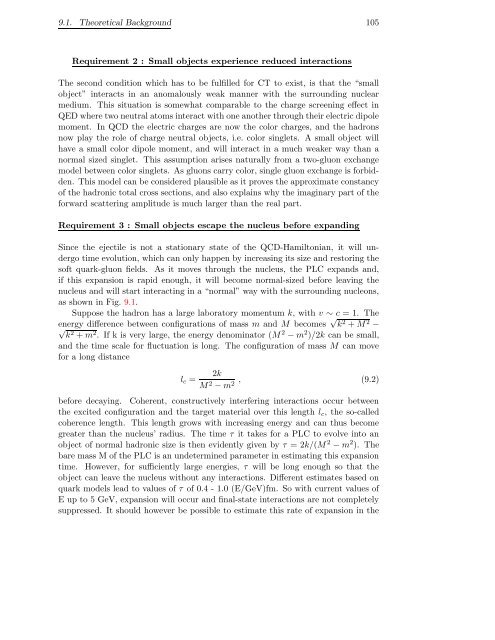Download Thesis in Pdf Format - Theoretical Nuclear Physics and ...
Download Thesis in Pdf Format - Theoretical Nuclear Physics and ...
Download Thesis in Pdf Format - Theoretical Nuclear Physics and ...
Create successful ePaper yourself
Turn your PDF publications into a flip-book with our unique Google optimized e-Paper software.
9.1. <strong>Theoretical</strong> Background 105<br />
Requirement 2 : Small objects experience reduced <strong>in</strong>teractions<br />
The second condition which has to be fulfilled for CT to exist, is that the “small<br />
object” <strong>in</strong>teracts <strong>in</strong> an anomalously weak manner with the surround<strong>in</strong>g nuclear<br />
medium. This situation is somewhat comparable to the charge screen<strong>in</strong>g effect <strong>in</strong><br />
QED where two neutral atoms <strong>in</strong>teract with one another through their electric dipole<br />
moment. In QCD the electric charges are now the color charges, <strong>and</strong> the hadrons<br />
now play the role of charge neutral objects, i.e. color s<strong>in</strong>glets. A small object will<br />
have a small color dipole moment, <strong>and</strong> will <strong>in</strong>teract <strong>in</strong> a much weaker way than a<br />
normal sized s<strong>in</strong>glet. This assumption arises naturally from a two-gluon exchange<br />
model between color s<strong>in</strong>glets. As gluons carry color, s<strong>in</strong>gle gluon exchange is forbidden.<br />
This model can be considered plausible as it proves the approximate constancy<br />
of the hadronic total cross sections, <strong>and</strong> also expla<strong>in</strong>s why the imag<strong>in</strong>ary part of the<br />
forward scatter<strong>in</strong>g amplitude is much larger than the real part.<br />
Requirement 3 : Small objects escape the nucleus before exp<strong>and</strong><strong>in</strong>g<br />
S<strong>in</strong>ce the ejectile is not a stationary state of the QCD-Hamiltonian, it will undergo<br />
time evolution, which can only happen by <strong>in</strong>creas<strong>in</strong>g its size <strong>and</strong> restor<strong>in</strong>g the<br />
soft quark-gluon fields. As it moves through the nucleus, the PLC exp<strong>and</strong>s <strong>and</strong>,<br />
if this expansion is rapid enough, it will become normal-sized before leav<strong>in</strong>g the<br />
nucleus <strong>and</strong> will start <strong>in</strong>teract<strong>in</strong>g <strong>in</strong> a “normal” way with the surround<strong>in</strong>g nucleons,<br />
as shown <strong>in</strong> Fig. 9.1.<br />
Suppose the hadron has a large laboratory momentum k, with v ∼ c = 1. The<br />
energy difference between configurations of mass m <strong>and</strong> M becomes √ k 2 + M 2 −<br />
√<br />
k 2 + m 2 . If k is very large, the energy denom<strong>in</strong>ator (M 2 − m 2 )/2k can be small,<br />
<strong>and</strong> the time scale for fluctuation is long. The configuration of mass M can move<br />
for a long distance<br />
l c =<br />
2k<br />
M 2 − m 2 , (9.2)<br />
before decay<strong>in</strong>g. Coherent, constructively <strong>in</strong>terfer<strong>in</strong>g <strong>in</strong>teractions occur between<br />
the excited configuration <strong>and</strong> the target material over this length l c , the so-called<br />
coherence length. This length grows with <strong>in</strong>creas<strong>in</strong>g energy <strong>and</strong> can thus become<br />
greater than the nucleus’ radius. The time τ it takes for a PLC to evolve <strong>in</strong>to an<br />
object of normal hadronic size is then evidently given by τ = 2k/(M 2 − m 2 ). The<br />
bare mass M of the PLC is an undeterm<strong>in</strong>ed parameter <strong>in</strong> estimat<strong>in</strong>g this expansion<br />
time. However, for sufficiently large energies, τ will be long enough so that the<br />
object can leave the nucleus without any <strong>in</strong>teractions. Different estimates based on<br />
quark models lead to values of τ of 0.4 - 1.0 (E/GeV)fm. So with current values of<br />
E up to 5 GeV, expansion will occur <strong>and</strong> f<strong>in</strong>al-state <strong>in</strong>teractions are not completely<br />
suppressed. It should however be possible to estimate this rate of expansion <strong>in</strong> the















